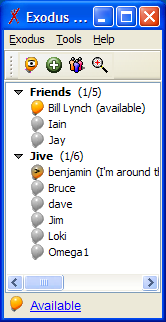The roster lets you keep track of the availability ("presence") of other users. A roster also allows you to organize users into groups such as "Friends" and "Co-workers". Other IM systems refer to the roster as the buddy list, contact list, etc.
A Roster instance is obtained using the XMPPConnection.getRoster() method.
Roster Entries
Every user in a roster is represented by a RosterEntry, which consists of:
Roster roster = connection.getRoster();
Collection<RosterEntry> entries = roster.getEntries();
for (RosterEntry entry : entries) {
System.out.println(entry);
}
Methods also exist to get individual entries, the list of unfiled entries, or to get one or
all roster groups.
Presence

Every entry in the roster has presence associated with it. The Roster.getPresence(String user) method will return a Presence object with the user's presence or null if the user is not online or you are not subscribed to the user's presence. Note: typically, presence subscription is always tied to the user being on the roster, but this is not true in all cases.
A user either has a presence of online or offline. When a user is online, their presence may contain extended information such as what they are currently doing, whether they wish to be disturbed, etc. See the Presence class for further details.
Listening for Roster and Presence Changes
The typical use of the roster class is to display a tree view of groups and entries along with the current presence value of each entry. As an example, see the image showing a Roster in the Exodus XMPP client to the right.
The presence information will likely
change often, and it's also possible for the roster entries to change or be deleted.
To listen for changing roster and presence data, a RosterListener should be used.
To be informed about all changes to the roster the RosterListener should be registered
before logging into the XMPP server.
The following code snippet registers a RosterListener with the Roster that prints
any presence changes in the roster to standard out. A normal client would use
similar code to update the roster UI with the changing information.
Roster roster = con.getRoster();
roster.addRosterListener(new RosterListener() {
// Ignored events public void entriesAdded(Collection<String> addresses) {}
public void entriesDeleted(Collection<String> addresses) {}
public void entriesUpdated(Collection<String> addresses) {}
public void presenceChanged(Presence presence) {
System.out.println("Presence changed: " + presence.getFrom() + " " + presence);
}
});
Adding Entries to the Roster
Rosters and presence use a permissions-based model where users must give permission before they are added to someone else's roster. This protects a user's privacy by making sure that only approved users are able to view their presence information. Therefore, when you add a new roster entry it will be in a pending state until the other user accepts your request.
If another user requests a presence subscription so they can add you to their roster, you must accept or reject that request. Smack handles presence subscription requests in one of three ways: